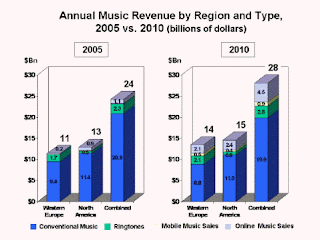
There are all kinds of music business models developing these days, including donations, music as loss leader, music as a "free razor," live performance, pay service, merchandising and so forth. People still consume in the old ways as well. Some people listen to radio, buy CDs or singles. People still go to live performances. But lots of people simply download single songs they like for 99 cents, or do so illegally.
The point is that the music ecosystem is developing lots of business models. My kids insist that 99 cents is the right price for a song, based on what a CD costs, and the number of songs on it. But they don't generally buy many CDs, unless an artist manages to pack so many songs on a collection that the incremental cost of buying the CD is quite low. But the business model behind 99-cent songs is the sale of hardware called iPods.
For Target or Wal-Mart, selective deep-discount sales of audio and video are loss leaders for the business model called "retail." Some acts have tried a donations model, with results being that 15 percent or fewer people actually donate.
Madonna, though, illustrates the shift as well as anybody. She last year signed a historically unusual recording and touring contract with concert promoter Live Nation. No record label: a concert promoter.
Traditionally, companies like Warner Music Group have focused on recorded music, while other firms have arranged tours, managed artists and sold merchandise. But shrinking CD sales have led artists and entertainment companies to consider wide-ranging deals that bring all activities under one roof, helping cross-promotion and boosting profit margins.
She is the first major star to choose an all-in-one agreement with a tour company over a traditional record deal. The point is that all albums, tours, merchandise, websites, DVDs, sponsorship, TV shows and films now are seen as parts of the business model.
"The paradigm in the music business has shifted," she is reported by BBC to have said.
In the old days, a musician would go on tour to promote a new album. The new model is more likely to take the form of albums being released for free or very low cost, to promote higher-priced tickets for live performances and other forms of monetization. In the past, promotions such as concerts were intended to sell records. In the future, records might be merchandising to build a reputation to sell concert tickets, create TV shows and sell merchandise.
It isn't immediately clear how changes in the music business might one day filter over into the video business, or how the basic principles might be applied to the communications business. But there's something to be learned here.
Among the insights is that the value users place on something change over time. What is the value of a car radio for someone who does not commute 60 minutes to two hours a day? What is the value of a car radio for somebody who can use an MP3 or CD player in the vehicle? The point is that the value of different types of music listening, as well as the cost, vary from mode to mode.
The "cost" of listening to the radio is virtually free (the radio came with the car), but maybe unsatisfying and rare. The cost of listening to MP3s is the cost of the content purchased and the player (unless the player came with the car), and might cost a bit more, but get used more, both inside and outside the vehicle.
In other cases the cost of music might be a satellite radio subscription and the cost of the receiving hardware (again, unless the hardware was built into the vehicle), but used only inside the car.
Also, the value of the ecosystem surrounding a product can produce more revenue than the actual tangible product. Let's say you buy a $250 phone (subsidized by the carrier to the tune of $200) and purchase a $5 a month insurance policy on the device, on a $55 recurring monthly plan. Say you never actually lose or break your phone, and you use it for three years.
Say a carrier's gross margin on services is about 30 percent (after paying employees, operating and marketing expenses, but before taxes, depreciation or debt service). Before subtracting the handset subsidy, the gross profit would be $16.50 a month on the service, or $198 a year and $594 over three years. Back out the $200 handset subsidy and one derives $394 as the gross profit on service.
Assume the insurance policy has a 90-percent gross margin, equating to $4.50 a month, $54 a year or $162 over three years. In that case, the $5 insurance revenue stream produces 29 percent of the gross profit, compared to the $55 revenue stream for service.
New business models for music are evolving. The issue is whether new business models for communication also might evolve.






